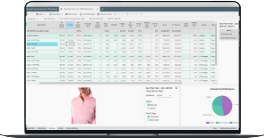How well do you know your customers?
You probably have an idea of who your customers are, and the demographics you’re targeting: Their style, color and size choices, how much they spend and what their budget is, and where they like to shop.
But until you’ve confirmed this information with actual data, it remains nothing more than an idea — an untested hypothesis. And until you’ve tested and confirmed this hypothesis, you’re missing out on opportunities to improve your buying and planning, reduce markdowns and inventory clearances, and spend your marketing dollars more effectively.
See also: How To Buy Based On Customer Demand
Why knowing who your customers are matter
How well you know your customers has a direct impact on your bottom line. Just consider the following two scenarios:
Inventory: Winter is coming, so it’s time to update your outerwear collection. Your hypothesis is that you have a large group of customers that are high income, high-fashion trendsetters; you buy a large assortment of the latest leather and wool overcoats and accessories. But what if the majority of your shoppers are more price conscious, and are looking for more affordable options? Or worse yet, are in warmer climates, and are only interested in lightweight outerwear? These shoppers aren’t buying wool or leather, leaving you with coats and gloves you can’t sell. That means warehouses and back rooms stuck with product that isn’t moving, and eventually, clearance sales; it also means you didn’t deliver a positive shopping experience for your customers.
Marketing: You’re preparing a back-to-school campaign. You’ve got a great new line of kids clothing for ages 6-10, so you want to target their parents. You produce an expensive series of TV spots and use the videos in an extensive series of Facebook ads, based on your hypothesis that your shoppers are middle income, medium-budget spenders who are slow to adapt to new trends. But if the parents you’re targeting are in fact first adaptors, and are no longer watching cable TV or using Facebook regularly, your campaigns are missing the mark, and you’ve wasted your marketing budget on the wrong audience.
In both cases, you’ve not only spent money you can’t get back, but your customers have taken their business elsewhere.
The best plans and decisions come from hard data. The more data you have on what your customers want, how much they want to spend and when they buy, the better. With customer data, you can make better marketing, assortment planning and buying decisions.
Start by getting to know your customers better
The good news is, with all of the technology we have at our disposal, it’s easier than ever to get to know our customers better, and to build customer profiles that help us more specifically identify who customers are and what individual customers want. This is the data that can be used to confirm and/or course-correct our hypotheses as noted above, and give us data to help identify broader trends on the macro level.
Here are three ways to get started:
1. Capture customer analytics
Your website is a treasure trove of customer data; every link clicked, every page visited, tells you something about your shoppers.
There are many tools that allow you to track specific information, including the following:
- Geographic area your visitors are in
- What web pages they came from before visiting your site
- What terms they searched that brought them to your site
- What pages they visited, and how long they stayed on each page
- And more…
If your customers are buying online, you’ve hit a veritable jackpot. You now have their email address and contact info to create an individual profile; you know what they’ve purchased, how much they’ve spent and over time you can observe specific trends. You’ll also be able to cross-reference similar customers and determine what customers typically buy after buying a specific item, and segment your customers into groups for future marketing campaigns.
Tips for capturing customer analytics:
- Beware of becoming “big brother;” ensure your privacy terms are front and center.
- Always comply with anti-spam laws before capturing data or contacting a customer.
2. Introduce a customer loyalty/rewards program
There’s a reason why seemingly every store, coffee shop and gas station has a rewards program these days: It’s because they help you get to know your customers better than just about anything.
Getting a customer into your loyalty program is easy enough with the right incentive (sign up now to receive 10% off, for example), and keeping them in with the promise of long-term rewards (such as points that eventually accumulate towards a discount) has proven extremely effective. In exchange for giving up those discounts, you get to gather data from your customer on every purchase or interaction they have with you.
Tips for a great loyalty program experience:
- Make it easy to sign up and use; be wary of asking customers to jump through too many hoops, including asking them to carry another card in their wallet.
- Remember that getting customers into the program is critical; entry needs to be as friction-free as possible. You can always collect more data later!
3. Conduct a customer survey
Sometimes they best way to get to know someone is to simply ask! It may seem old-fashioned, but a survey is a tried-and-true tactic for gathering customer information. It’s inexpensive and easy to do, especially with today’s digital tools. You can incentivize your customers to participate (with a discount or coupon for a future purchase, for example) but even without an incentive, a survey can still provide valuable information.
Tips for conducting surveys:
- Choose the right time and place to ask your customer to take a survey; don’t spam them with too many emails.
- Make it simple and fast; you’re better off asking for three 2-minute surveys over 12 months than one 5-minute survey.
- Ask one question at a time, and ensure your questions are relevant both to you, and your customers.
Building — and using — accurate customer profiles
Once you’ve collected all of this customer data, you can use it to build customer profiles: Segments or groups of customers with similar characteristics to whom you can then accurately market and sell to.
These profiles can be grouped by multiple criteria, such as income profile, age, and location, as well as specific shopping tendencies like shared behaviours and purchases.
Once you have your segments defined, you can target those segments with the items and offers that will appeal to them (rather than a one-size-fits-all-approach), giving your customers a sense of trust that you understand them and their needs — and ensuring your planning, purchasing and marketing the right items.
It’s important to note that your profiles and segments are always evolving; the good news is that, over time, as more transactions (and more data) you accrue, you can continue to further refine your segments and continually improve your profiles and your purchasing and marketing accuracy.
Getting to know your customers today will provide long-term benefits
Understanding your customers is key to achieving success as a retailer in today’s competitive environment. Getting to know what your customers like, how and when they like to shop and how much they like to spend, can go a long way towards ensuring you’re planning and buying right.























